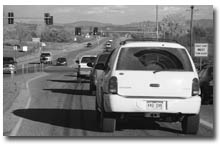|  Up
north in Boulder County Up
north in Boulder County
Boulder County began its transferable
development rights program in 1995. Since its inception, nearly
4,500 acres of land have been preserved as open space. However,
the birthplace of much of the state’s revolutionary planning
has also gone about things a little differently.
“It’s a little different
than the typical TDR programs because we don’t offer developers
an enormous bonus density,” says Peter Fogg, Boulder County’s
manager of long-range planning.
Prior to 1995, developers had
to bring 35 acres to the table for every two units they wished
to develop. At that time, regulations changed to allow only one
unit per 35 acres. However, if a developer brought an adequate
number of transferable development rights, he or she would be
allowed three units per 35 acres.
“Our regulations became
more restrictive,” says Fogg. “So it was kind of a
push-pull situation. Plus, our system is entirely voluntary.”
In Boulder County, TDR negotiations
are conducted exclusive of government influence. The developer
also selects the site to be preserved and then proposes it to
county officials. “We leave a lot of it up to the developer,”
says Fogg. “It was clear that if we designated specific
sites, it would have done bad things to land values.”
The place where the county does
do substantial work is in negotiations with municipalities and
making sure growth goes where it is appropriate. “We try
to make it attractive to the cities to accept receiving sites
near their edges,” says Fogg.
Fogg adds that in spite of widespread
skepticism, the program has paid off.
“To some people’s
surprise, including mine, it’s worked quite well,”
he says. “I didn’t think this would offer developers
enough incentive.”
After nearly eight years of
the program, Fogg can say that it has been effective but primarily
because of tighter regulation. In the case of a purely voluntary,
incentive-based system, he says it could be more difficult.
“It’s kind of a
tough one because there’s a fine line between offering it
as an additional option and tightening down the other bolts and
steering developers in that direction,” he says. “You
really need to consider offering considerably higher density.
I think it’s only realistic that you’re going to have
to give a good bonus.”
Where are the
dollars?
In 1996, a rancher and biologist
crossed party lines and created the Gunnison County Ranchland
Conservation Legacy. Their goal was the preservation of agricultural
lands and operations that were threatened by development. To do
this they created an organization that would acquire funding to
buy development rights. To date, the Ranchland Conservation Legacy
has acquired 18 ranches totaling 9,490 acres, and rather than
using developers for funding, they tapped grant funding, particularly
millions of lottery dollars from Great Outdoors Colorado.
However, a decade later, the
organization still has a waiting list that is 42 families and
30,000 acres deep and is facing dwindling funding. “We have
a huge number of people on our waiting list but not enough funding,”
says executive director Lucy High. “The funding agencies
are getting pickier all the time.”
As a result, the group has started
a broad search for funding mechanisms. One of these roads has
led to the Gunnison County Land Preservation Board, which assesses
impact fees on developers in order to acquire open space. Much
like transferable development rights, the board recently voted
to leverage against these fees in order to go into debt to the
tune of $1.2 million in part to help the Ranchland Conservation
Legacy begin to acquire the ranchland before it becomes sprawl.
Speaking to the positive impact
of buying development rights, High says: “This program offers
a way for ranchers to stay in business and be compensated for
the public benefit they are providing in terms of open space,
habitat and quality of life. It’s not a panacea for this
nation’s agricultural problems, but I know it’s made
the difference for a lot of people in Gunnison County.”
Whether buying development rights
will make the difference for property owners in La Plata County
and whether a TDR system can even be implemented here remain large
unknowns. However, county planners are now committed to answering
these questions over the next few months.
|

